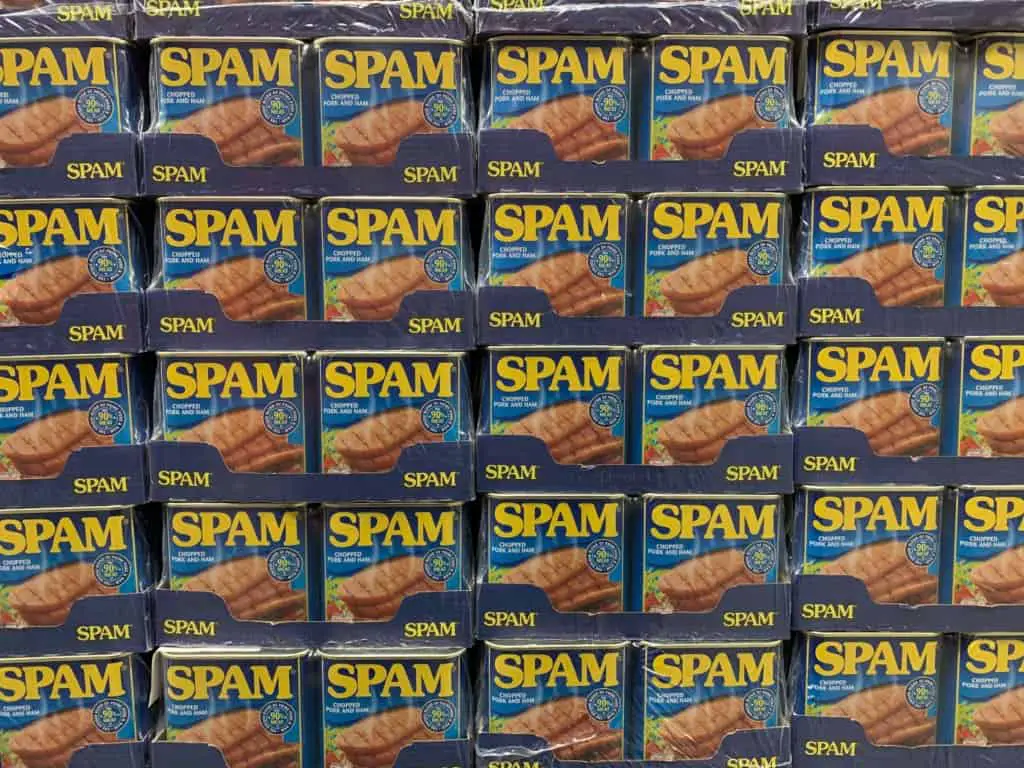
Ah… SPAM. There is so much to be said about this timeless product. Where do we begin? How about we start with how SPAM tastes. Some people think it tastes like heaven in a can, but what about those of us who have never tried it? What does SPAM taste like?
Classic SPAM tastes like salty ham lunchmeat, with a moist and spongy texture similar to sausage patties. Newer versions of SPAM have a variety of spices, peppers, and additional ingredients that broaden the available flavors.
SPAM has been immortalized in awesome ways throughout its history, including a song about it from Monty Python. If you want to know more about SPAM and how to cook with it, keep reading to learn more:
Table of Contents
What Does SPAM Taste Like?

To explore this, we should first discuss what the name SPAM stands for.
Guesses range from a shortened version of “spiced ham” to “Specially Processed American Meat.” No matter what it is called or how it got its name, SPAM is just SPAM.
The taste of SPAM is a salty, and slightly spicy, ham flavor. And whether or not it tastes “good” varies drastically depending on who you ask.
People who grew up with it often find it to be fine, good, or even delightful. Others may find it to be absolutely disgusting.
Personally, I think SPAM tastes fine, but it’s a bit too salty on its own. So, I think it’s best when eaten with other foods that need some extra salt (like rice, eggs, etc.).
SPAM also tends to offer slightly different flavors, depending on how it is prepared and eaten. And it isn’t expensive, so your best bet is to peruse some recipes, buy a can, and give it a taste test on your own.
What is SPAM Made of?
SPAM has a simple list of ingredients:
- Pork with ham
- Salt
- Water
- Potato starch
- Sugar
- Sodium nitrate
According to the official SPAM website, SPAM does not contain a lot of chemical additives. That might surprise you given that it’s a processed prepared food.
Another interesting thing about SPAM is that it’s gluten-free. While you might expect it to contain a lot of filler ingredients, it doesn’t. It is meat.
Some varieties contain other ingredients, such as peppers, cheese, and other flavor-enhancing items, but basic SPAM is just meat.
In total, there are 15 varieties of SPAM currently available. Original SPAM remains unchanged from its early days.
Simply put, SPAM is spiced luncheon meat. It is shelf-stable and sold in easy-to-access packaging. Cans have pop-tops, and foil packets have tear-off seals. SPAM is a great go-to for any meal, with a ton of recipes.
Cooking SPAM

You bought your SPAM, and now you need to know what to do with it.
Open the can. Turn it open-end-down over a plate and gently squeeze the ends to release the vacuum seal. You may have to shake the can a bit. Sometimes it helps to run a butter knife around the edge of the can. Once the seal is broken, your meat will slowly plop onto your plate.
You will notice a thin layer of goo. This is just rendered fats from the canning and cooking process. It is edible, but most people scrape it off and discard it. This is the part most people find disgusting about SPAM.
If you are frying your SPAM, the gel from the can will add flavor if you toss it the frying pan.
SPAM cuts nicely using a standard butter knife with a serrated or straight edge. While it can be eaten cold right out of the can, most people prefer to eat it cooked. To help you figure out how to prepare some gourmet SPAM, we scrounged up a few favorite recipes:
SPAM Fried Rice or SPAM and Eggs
For these, you want to dice your SPAM into half-inch or smaller pieces. Fry them in a pan until they get a little color, and the edges are starting to crisp up.
After making some rice in your rice cooker, add the SPAM to your favorite fried rice recipe, stir and heat until it reaches the desired temperature.
This can be served as a main entrée or as a side dish. It makes a great potluck-covered dish for a summer BBQ. Use your imagination.
SPAM and eggs is a great way to start your day.
Just add your diced, fried chunks to scrambled eggs or an omelet, toss in some shredded cheese and enjoy. A particular favorite of mine is to combine scrambled eggs, SPAM, tater tots, cheese, and onions in a bowl and top it with a ladle of white gravy. Not healthy, but it tastes real good.
SPAMburgers
A SPAMburger is just that – a patty made by slicing the meat a bit thicker along the square side. To prepare a SPAMburger, you can fry it in a pan, grill on the BBQ, broil it, or even microwave it.
Add a slice of cheese, toss it on a bun (or between two slices of bread), and then add your favorite condiments.
Preparing SPAM is interesting, but honestly, one of the most fascinating things about SPAM is it’s history. Read a bit about it below. It might even give you an extra appreciation for SPAM when you try it.
A Brief History of Spam

SPAM was developed during World War II. It received its official name in 1937 when Ken Daigneau won $100 with his contest entry suggestion. The meat product quickly became a staple for the US military. Soldiers consumed more than 100 million pounds between 1941 and 1945.
To promote goodwill and brand awareness, Hormel sponsored a performance group known as “The Hormel Girls.” They traveled the country to support the end of the war and to promote Hormel products.
Then, after WWII, here are some other big milestones for SPAM:
- 1959 – One billion cans passed through production
- 1962 – A smaller, 7-ounce can began production
- 1970 – Production of two billion cans celebrated
- 1971 — First flavored varieties of SPAM: Hickory Smoked and Cheese.
The three billion mark was passed in 1980. In 1986, Hormel introduced the low-sodium version of SPAM. As an alternative for health-conscious consumers, this version offered a (slightly) healthier version of the popular luncheon meat.
Then, the 1990s brought several more big milestones for SPAM:
- 1991 – First SPAM Museum opened in Austin, MN
- 1992 – SPAM Lite debuted with 25 percent less fat and sodium
- 1994 – Five billion cans sold
- 1995 – SPAM sponsored a car on the Winston Cup Series
- 1998 – SPAM made it to the Smithsonian
SPAM continues into the new century with new varieties and new packaging. Here are some of the most recent developments in the world of SPAM:
SPAM Adds New Twists
In 2017, SPAM celebrated its 80th birthday. It was probably inevitable; in the era of pumpkin spice everything, SPAM introduced a limited-edition pumpkin spice version in 2019.
Let no taste combination be untried seems to be the reigning motto at Hormel. There are currently 15 varieties of SPAM available. Limited-edition products mean there are sometimes 22 choices on the shelves.
How SPAM is Made
The one thing that has never changed is the process of making SPAM:
- The pork and ham are ground
- Spices and other ingredients are added
- The mixture is heated and then sent to the canning area
- The warm mixture is then placed into the rectangular 12-ounce cans, vacuum-sealed, and cooked fully (yes, in the cans)
- After cooling, the cans are labeled and prepared for shipping.
A Couple Extra Fun Facts
The world, as measured with SPAM, is 415,549,599 cans around the circumference. Big Ben (the clock tower in England) is 1,163 cans tall.
SPAM is considered a luxury gift in Southeast Asia. In America, SPAM remains popular, but it rules the island state of Hawaii. Hawaiians consume 7 million cans of SPAM per year.
Now you know some history, the process of creation, and how SPAM stacks up around the world, but we still haven’t answered the final question.
Is SPAM Worth Trying?
We think so, but if you’re trying it for the first time, cook some eggs and/or rice to go with it. There are a lot of recipes available on the official SPAM website. Buy a can, find a recipe that tempts your taste buds, and try it.
